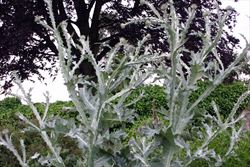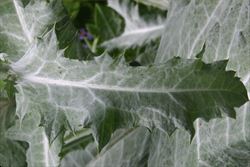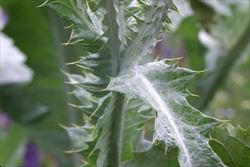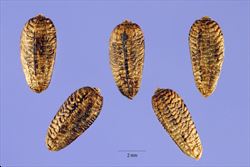Click on images to enlarge

habit (Photo: Trevor James)

habit in flower (Photo: Trevor James)

rosette of lower leaves (Photo: Trevor James)

upper leaf (Photo: Trevor James)

close-up of the spiny, winged, stems (Photo: Trevor James)

young flower-heads with narrow spines (Photo: Trevor James)

close-up of seeds without hairs (Photo: Steve Hurst at USDA PLANTS Database)
Scientific Name
Onopordum acanthium L.
Synonyms
Onopordum acanthium L. subsp. acanthium
Family
Asteraceae (Queensland, New South Wales, the ACT, Victoria, Tasmania, Western Australia and the Northern Territory)Compositae (South Australia)
Common Names
cotton thistle, giant thistle, heraldic thistle, Scotch cotton thistle, Scotch cottonthistle, Scotch thistle, Scottish thistle, silver thistle, woolly thistle
Origin
Native to Europe (i.e. Austria, Czechoslovakia, Germany, Hungary, Switzerland, Moldova, Ukraine, Albania, Bulgaria, Greece, Italy, Romania, Yugoslavia, France, Portugal and Spain), western and central Asia (i.e. Afghanistan, Iran, northern Iraq, Turkey, Armenia, Azerbaijan, Georgia, southern Russia, Kazakhstan, Kyrgyzstan, Tajikistan and Turkmenistan) and Pakistan.
Naturalised Distribution
This species is widely naturalised in the temperate regions of south-eastern Australia. It is most common in the sub-coastal regions of central and southern New South Wales and eastern Victoria. Also naturalised in Tasmania, in the ACT, on Lord Howe Island and in the southern parts of South Australia, and scattered throughout much of the rest of Victoria and New South Wales.
Scotch thistle (Onopordum acanthium) has also become widely naturalised across much of North America.
Habitat
A weed of pastures, crops, disturbed sites, waste areas, gardens and roadsides. It is mainly found in temperate regions, but occasionally also grows in semi-arid and sub-tropical environments.
Habit
An upright (i.e. erect) and short-lived (i.e. annual or biennial) spiny herbaceous plant usually growing 1-1.2 m tall, but occasionally reaching up to 2 m in height. It forms a large basal rosette of leaves during the early stages of growth.
Distinguishing Features
- a large, short-lived, spiny thistle growing up to 2 m tall.
- its stems are broadly winged and are densely covered in whitish hairs that give them a cottony appearance.
- its elongated leaves have irregularly toothed or deeply divided margins and often have a distinctive bluish-grey appearance.
- its large purplish flower-heads (2-6 cm across) are surrounded by several rows of spine-tipped bracts.
- ts seeds (4-5 mm long) are grey with darker mottling and are topped with a ring of whitish-coloured hairs (5-10 mm long).
Stems and Leaves
This plant usually has a single main stem with several branches in its upper parts. Both the main stem and the branches are broadly winged. These wings are about 10 mm wide and armed with numerous spines. Stems are densely covered in close-lying (i.e. appressed) hairs that give them a whitish cottony appearance.
The leaves are similarly covered in white cottony hairs, particularly on their undersides, and also possess numerous spines (up to 10 mm long) along their margins. They are usually elongated (i.e. broadly lanceolate) in outline with irregularly toothed (i.e. serrated) or deeply divided margins. These leaves often have a distinctive bluish-grey (i.e. glaucous) appearance. Rosette leaves are stalked (i.e. petiolate), very large (10-40 cm long and 3-10 cm wide) and relatively broad. Stem (i.e. cauline) leaves are alternately arranged, stalkless (i.e. sessile), and become smaller and narrower towards the top of the plant.
Flowers and Fruit
The flower-heads (i.e. capitula) are borne singly, or in small groups of two or three, at the tips of the branches. They are purple, reddish-purple or mauve in colour, thistle-like, and do not have any obvious 'petals' (i.e. ray florets). These flower-heads (2-6 cm long and about 4 cm wide) consist of numerous small tubular florets surrounded by large numbers of spiny bracts (i.e. an involucre). Each bract (about 25 mm long) has a woolly-hairy base and a sharp spine at its tip which is yellowish or orange in colour. Flowering occurs mostly during spring and summer (i.e. from August to December).
The elongated 'seeds' (i.e. achenes) are mostly grey in colour, with darker mottling, and have a somewhat wrinkled (i.e. rugose) surface. These 'seeds' (4-5 mm long) are topped with a ring (i.e. pappus) of toothed, whitish-coloured hairs (5-10 mm long) that easily become detached when the seed is mature.
Reproduction and Dispersal
This species usually reproduces by seed, although severed root fragments can give rise to new plants after being cut and spread by cultivation equipment.
There is little dispersal of the individual seeds by wind, although the whole seed-head may detach and spread seeds about in this manner. Seeds are more often dispersed after becoming attached to animals, clothing and vehicles or they are spread in contaminated agricultural produce (e.g. hay, silage and grain).
Environmental Impact
Scotch thistle (Onopordum acanthium) is regarded as an environmental weed in the ACT. Though it is mainly a weed of agricultural areas in Australia, it was also recently listed as a priority environmental weed in two Natural Resource Management regions.
Legislation
This species is declared under legislation in the following states and territories:
- ACT: C3 - a pest plant that must be contained.
- New South Wales: Class 4 - a locally controlled weed. The growth and spread of this species must be controlled according to the measures specified in a management plan published by the local control authority and the plant may not be sold, propagated or knowingly distributed (in a large number of local authority areas). See the New South Wales Department of Primary Industries Noxious Weeds List at http://www.dpi.nsw.gov.au for more detailed information on which local areas are covered in these declarations. This declaration applies to all Onopordum thistles (i.e. Onopordum spp.).
- Tasmania: D - the importation or sale of this species is prohibited and measures to reduce its population in an area, eradicate it from an area, or restrict it to a particular area may be required. This declaration applies to all Onopordum thistles (i.e. Onopordum spp.).
- Victoria: P3 - prohibited and must be eradicated or controlled (in the Glenelg, North Central and Port Phillip East regions), and C4 - all reasonable steps must be taken to control the weed and prevent its spread (in the Goulburn, North East, West Gippsland and East Gippsland regions).
- Western Australia: Prohibited - on the prohibited species list and not permitted entry into the state.
Management
For information on the management of this species see the following resources:
- the Victorian Department of Primary Industries Landcare Note on this species, which are both available online at http://www.dpi.vic.gov.au.
- the Tasmanian Department of Primary Industries and Water weed service sheet on this species, which is available online at http://www.dpiw.tas.gov.au.
- the New South Wales Department of Primary Industries Agnote on Onopordum thistles, which is available online at http://www.dpi.nsw.gov.au.
Similar Species
Scotch thistle (Onopordum acanthium) is very similar to Illyrian thistle (Onopordum illyricum) and relatively similar to stemless thistle (Onopordum acaulon) when it is in the rosette stage of growth. These species can be distinguished by the following differences:
- Scotch thistle (Onopordum acanthium) is an upright (i.e. erect) plant with purplish coloured flower-heads. These flower-heads have numerous thin greenish-coloured bracts possessing mostly upward-pointing spines.
- Illyrian thistle (Onopordum illyricum subsp. illyricum) is an upright (erect) plant with purplish coloured flower-heads. These flower-heads have numerous broad purplish-coloured bracts possessing mostly outward and downward-pointing (reflexed) spines.
- stemless thistle (Onopordum acaulon) is a low-growing (i.e. prostrate) plant and does not produce stems. Its flower-heads are white or purple in colour and have numerous thin greenish-coloured bracts possessing mostly outward and upward-pointing spines.
Spear thistle (Cirsium vulgare), perennial thistle (Cirsium arvense), artichoke thistle (Cynara cardunculus), variegated thistle (Silybum marianum), nodding thistle (Carduus nutans subsp. nutans) and the slender thistles (Carduus pycnocephalus and Carduus tenuiflorus) may also be confused with Scotch thistle (Onopordum acanthium). They can be distinguished by the following differences, in addition to the fact that Scotch thistle (Onopordum acanthium) has greyish-coloured leaves:
- the slender thistles (Carduus pycnocephalus and Carduus tenuiflorus) and perennial thistle (Cirsium arvense) have smaller and much more slender flower-heads.
- spear thistle (Cirsium vulgare) has leaves with deeply cut lobes held at various angles (instead of toothed and undulating leaves) and its seeds have a pappus of feathery hairs up to 25 mm long (instead of toothed hairs up to 10 mm long).
- nodding thistle (Carduus nutans subsp. nutans) has flower-heads with purplish-coloured bracts and these flower-heads 'nod' or droop as they mature.
- variegated thistle (Silybum marianum) and artichoke thistle (Cynara cardunculus) have 'wingless' stems and larger flower-heads (up to 13 cm across).

